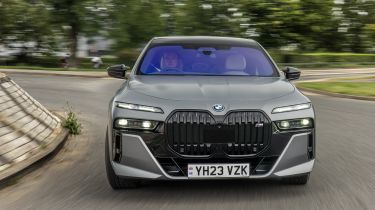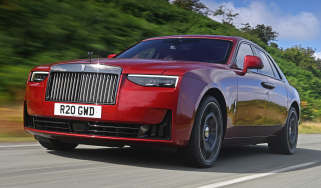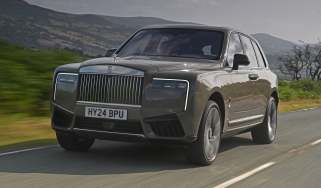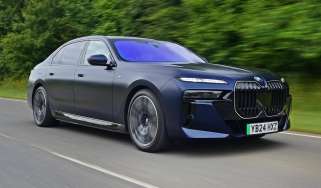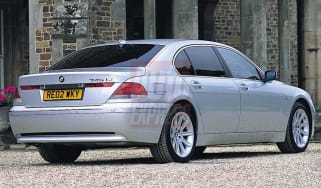BMW 7 Series review
Divisive styling doesn’t change the fact that the BMW 7 Series is one of the most impressive luxury vehicles on sale today

Whether you like the looks or not, the BMW 7 Series and its derivatives are amongst the best luxury vehicles you can buy today. It retains the key ability to waft very important people around in supreme comfort and quietness, and follows the latest advanced technology trends and the need to move toward electrification. BMW’s decision to offer both hybrid and pure EV versions of the 7 Series is a canny one because it means there’s a version for all tastes and business needs. The styling is undoubtedly bold and might be too aggressive for some, yet there’s no denying that the BMW 7 Series is a supremely luxurious car.
About the BMW 7 Series
Much like its most direct competition, the Mercedes S-Class, the latest BMW 7 Series is also in its seventh generation, with a heritage that dates back to the late ‘70s. In that time, the 7 Series has seen off numerous challengers in the luxury saloon car market, with today’s pool reduced down to the S-Class mentioned above, the Audi A8, Lexus LS, or the Porsche Panamera. If money is no object, you can also look at the Bentley Flying Spur and Rolls-Royce Ghost.
Buyers in this area of the market are also leaning towards far more versatile luxury SUVs such as the Audi Q7, Bentley Bentayga, BMW X7, Range Rover, and Range Rover Sport, as well as all-electric alternatives including the Mercedes EQS and BMW’s own i7 - the EV version of the 7 Series.
Used - available now

2020 BMW
7 Series
20,522 milesAutomaticPetrol3.0L
Cash £29,600
2019 BMW
7 Series
69,187 milesAutomaticDiesel3.0L
Cash £20,995
2022 BMW
7 Series
58,000 milesAutomaticPetrol3.0L
Cash £36,950
2019 BMW
7 Series
101,433 milesAutomaticDiesel3.0L
Cash £18,490Important people often travel in large luxury saloon cars, and it wouldn’t send out the right sort of message to arrive at a summit or highly publicised movie premier in something sporting a diesel engine, so those have been ditched for the latest 7 Series in favour of a range of plug-in hybrids. The range starts with a 750e xDrive that has nearly 50 miles of electric range, followed by a more potent M760e xDrive with a massive 571bhp on tap.
In the UK, there are two main trim levels: Excellence is the more comfort-orientated trim, and the familiar M Sport, which, as the name suggests, is on the sportier side and features bigger wheels and racier styling. Both trims can be upgraded to ‘Executive’ specification, with the latter trim gaining the option to go even further with an ‘Ultimate’ pack. It costs more than a Volkswagen Golf, but will give you the, erm, ultimate luxury experience.
Engines, performance and drive
The best luxury cars have a deft ability to defy their size and weight to give a driver the impression they are behind the wheel of something much smaller, all while cossetting passengers who might be dozing in the back. The BMW 7 Series nails each of those targets arguably much better than what was regarded as the gold standard in this class, the Mercedes S-Class.
Ride comfort is fantastic, smothering shocks from potholes at low speeds as well as gliding over motorway expansion joints at higher speeds. The thudding sound you’d expect to hear is also exceptionally well insulated from the cabin when encountering such an impact.
Around town, where many 7 Series’ will spend their life ferrying around dignitaries and celebrities, you’ll appreciate how quiet it is trundling around in its electric mode. The electric motor used in the M760e’s powertrain is wonderfully smooth and easy to modulate. Another plus is that the brake pedal feels natural and progressive, which helps the driver bring the car to an easy halt, which is much harder to achieve in the equivalent plug-in hybrid S-Class. We’re yet to try the entry-level 750e in the UK, but we expect its electric motor and brakes to perform similarly well.
The impressive level of comfort and refinement of the 7 Series will lead you to take for granted how competent it is in the corners. While the 7 Series isn’t the sort of car to hustle along a B-road, its composure, remarkably flat body control through corners, and high grip level are all very impressive. The optional rear-wheel-steering system helps to make it far more agile than expected, with a noticeable pivoting feeling in tighter turns as the back wheels turn in the opposite direction to the fronts. This drastically reduces the turning circle, making for easier low-speed manoeuvres. At higher speeds, the rear wheels turn in tandem with the fronts to aid stability.
The steering is light and direct, which also manages to mask the car’s weight. Resist the urge to look over your shoulder and see that enormous cabin behind, and it wouldn’t be hard to mistake the 7 Series for a smaller 5 Series-sized car. The brakes are strong and responsive, which is handy considering models like the M760e have huge straight-line performance.
At higher speeds, the ride of the adaptive air suspension remains settled yet controlled. Things become firmer (yet still very forgiving) when you switch to Sport mode, and the ride height drops by 10mm – that also happens at motorway speeds to aid aerodynamic efficiency. Much like it is around town, the cabin remains incredibly quiet.
0-62mph acceleration and top speed
Only two petrol plug-in hybrid options power the 7 Series. That might be an issue for those who do longer trips and rack up huge mileage. In that case, look at the S-Class instead because that has a choice of two diesel options.
However, the ability to zip around on electricity alone will be a real boon for those mostly driving in the city. The entry-level 750e has nearly 50 miles of electric range and a stout 489bhp. That’ll allow it to nip from 0-62mph in a mere 4.8 seconds.
The 0-62mph dash in the M760e takes just 4.3 seconds due to its strong 571bhp output. That’s perhaps overkill for a car such as this, but it is nice to know you’ll have the urgency to nip into a gap in the traffic. The hybrid system switches between petrol and electric modes very smoothly and manages nearly 48 miles on electricity alone despite its potent performance.
MPG, CO2 and running costs
Any individual or company looking to purchase a £100,000 luxury car isn’t likely to be too concerned about the day-to-day running costs of running such a car.
However, those getting a BMW 7 Series as a company car purchase can take advantage of its low plug-in hybrid emissions compared with the pure petrol and diesel alternatives of the Mercedes S-Class. And while its smaller 18.7kWh (useable) battery pack means it won’t be able to travel as far on a charge compared with the 21.5kWh (useable) pack in an S-Class, both currently sit in the same benefit-in-kind (BIK) taxation band. If you need something with a lower rate, then there is always the option of the all-electric BMW i7 to consider.
Fuel consumption (provided you regularly charge up) should be low. The best version is the 750e with an official figure of 282.5mpg, followed by the M760e with 256.8mpg. During our test of the M760e we pitched against the Mercedes S 580 e, the BMW managed 34.1mpg with a depleted battery, whereas the Mercedes achieved 36.3mpg.
The 750e and M760e can be charged up from flat to full from a 7.4kW wallbox charger at home in three hours, which is similar to how long it’ll take an S 580 e S-Class to charge up. The Mercedes can be rapid charged in 20 minutes, though.
Insurance groups
All versions of the 7 Series sit in the highest insurance group of 50, which is typical of luxury cars in this price range. You’ll have to shop around or look into a multi-car policy to find ways of reducing your insurance bill.
Check your tax status and renewal date in seconds. Check your VED car tax now...
Depreciation
This is an area of contention, but unfortunately, expensive luxury cars tend to lose value particularly quickly. The 7 Series is no exception because it’ll be worth 44-46% of its original value after three years or 36,000 miles.
The S-Class will be worth more over the same period, but if you can, try the all-electric i7. The least expensive xDrive50 Excellence or M Sport versions are predicted to retain 51% of their value.
To get an accurate valuation on a specific model check out our free car valuation tool...
Interior, design and technology
Any discussion regarding the 7 Series will start with its very imposing looks. Not only is it huge (and challenging to fit in a tight car park space), but its distinctive styling may raise a few eyebrows. The front is the most challenging view at an initial glance, but it soon grows on you. If you don’t like the enormous kidney grilles in blingy chrome, go for M Sport trim and add the M Sport Pro pack, because it gets a black alternative that isn’t as noticeable. At least the 7 Series isn’t your typical dull saloon to look at.
There are, however, many variations of grey in the 14-colour pallet, although a rich brown adds some variety. If you’re prepared to spend big, then there’s a two-tone option to really help your 7 Series stand out.
Sit in the driver’s seat, and the contemporary look, superb build quality and hi-tech surroundings are immediately apparent.
Up front, there’s the ‘BMW Interaction Bar’ spanning the dashboard and onto the inner door panels, which serves three roles. Firstly, it displays fancy ambient lighting graphics based on different themes, such as ‘efficiency’ and ‘sport’. Secondly, it can provide visual feedback for safety reasons (a proximity warning, for example). It also acts as a surface for some controls, including the front and rear window demisting buttons.
You’ll find the hazard light button in the middle, but ideally it would be elsewhere – it requires a surprisingly hard push to engage or disengage, causing the plastic lens of the Interaction Bar to creak. It’s one of the few areas where we can question the quality of the car; in the main, the 7 Series feels like a very well-made and premium offering.
On the inside of the back doors are two small touchpads that rear-seat passengers can use for myriad functions, including climate control and seating position. While easy enough to navigate, they could be more responsive.
Sat-nav, stereo and infotainment
The biggest infotainment news for the 7 Series is its optional BMW Theatre screen, which is a 31.3-inch 8k touchscreen that smoothly folds out from the headlining (in sync with the electric rear blinds closing for the full cinema experience) and boots up to present a device that runs Amazon’s Fire TV.
The screen’s resolution is razor sharp, and it can be positioned either close to the occupants in order to easily confirm selections on the touchscreen, or further away to make the most of viewing films and television shows.
Sound is catered for by UK firm Bowers & Wilkins. There are two systems to choose from; the standard version has 18 speakers and a 655-Watt output, while the uprated system Diamond Surround sound system comes as part of either the Technology Pack Plus or the Ultimate Pack. It doubles the speaker count and lifts power to 1,965 Watts. It’s an awesome system, but you’ll need to be a real connoisseur to warrant its hefty price tag.
Practicality, comfort and boot space
The latest 7 Series is certainly opulent inside, with the front seats being particularly sumptuous with a wide range of adjustment. We found the level of the dashboard line quite high, which means you need to raise the front seats more than you might expect to ensure decent visibility.
The side and rear pillars are thick and don’t help visibility, so it's just as well the 7 Series has blindspot detection as standard, along with front- and rear parking sensors, and a back-up camera. The optional Parking Assistant Pro gives you a 360-degree camera system.
Speaking of technology, those up front are still well catered for with the 14.9-inch central infotainment system running BMW’s latest iDrive software. It’s menus are getting a little complicated to navigate with all the features it now has, but the handy rotary controller near the gear lever with its shortcut buttons makes it easier to use on the move than rival systems.
There’s a huge glovebox, deep door bins front and rear, and generous storage under the central armrests for both rows, meaning plenty of hiding spots for your odds and ends. In the rear, a pair of cup holders slide out from within the central armrest, and a couple of USB-C ports sit inside its cubby. The optional Travel and Comfort System adds a pair of tablet holders for rear-seat passengers, plus an extra USB-C port for each.
We’d recommend getting the Executive Pack (which includes the Rear Seat Comfort Pack) because it adds electrically adjustable and massaging rear seats, which can be reclined for greater rear seat comfort. It’ll be a useful option for those buying the 7 Series as a chauffeur car.
Dimensions and size
Even compared with its sizeable predecessor, the seventh-generation 7 Series has grown a little larger. At 5,391mm, it’s 130mm longer, plus it’s 48mm wider and 5mm taller, too.
That makes it even longer than the elongated long-wheelbase S-Class, although the width is similar for both luxury cars.
Leg room, head room & passenger space
Predictably, rear-seat space and comfort are brilliant in the 7 Series. Headroom and knee room are plentiful, and the seats are wide and soft. Buyers who plan to be driven, rather than drive, will certainly feel like they’re getting their money’s worth with the BMW limousine.
The only downside is a broad transmission tunnel running through the middle that takes up foot space.
Boot space
On paper, the German model’s 525-litre boot volume seems impressive. However, it’s a little smaller than what’s offered in the S-Class and is quite an awkward shape. Most of the load bay’s capacity is achieved in its length – it measures 1,130mm from the back seats to the boot lip – but with a narrow opening and steps in the boot floor itself, it’s not an easy space to exploit when carrying luggage.
Reliability and safety
Euro NCAP hasn’t tested the BMW 7 Series, but we suspect it’ll be a very safe car given its comprehensive standard safety equipment list, including lane keep assistance, autonomous emergency braking, and blind spot monitoring. The Mercedes S-Class doesn’t have a rating either.
The 7 Series is too new to have been included in our latest Driver Power ownership satisfaction survey, but BMW as a brand still has some work to do because it came in a rather disappointing 21st place out of 32 manufacturers. That beat Mercedes, but fell way behind the likes of Lexus and Porsche.
Warranty
The 7 Series has a fairly typical three-year warranty period, but the unlimited mileage period matches what Mercedes offers for the S-Class.
The high-voltage battery used for the plug-in hybrid system is covered by a separate warranty of up to six years or 60,000 miles.
Servicing
You can set up a servicing plan for your 7 Series that covers two services and is based on your predicted annual mileage. This can be set up as a monthly payment or paid for in full.
